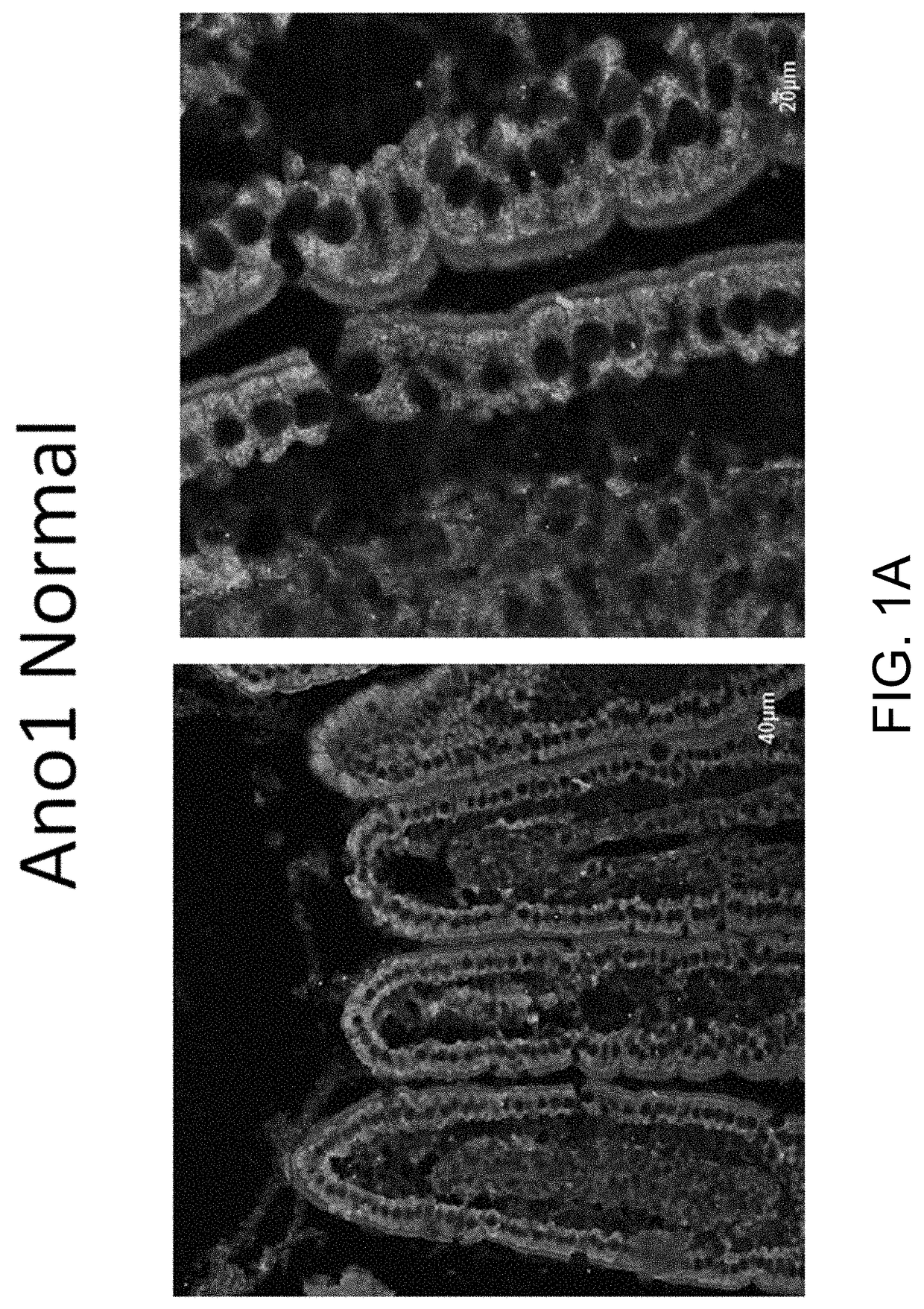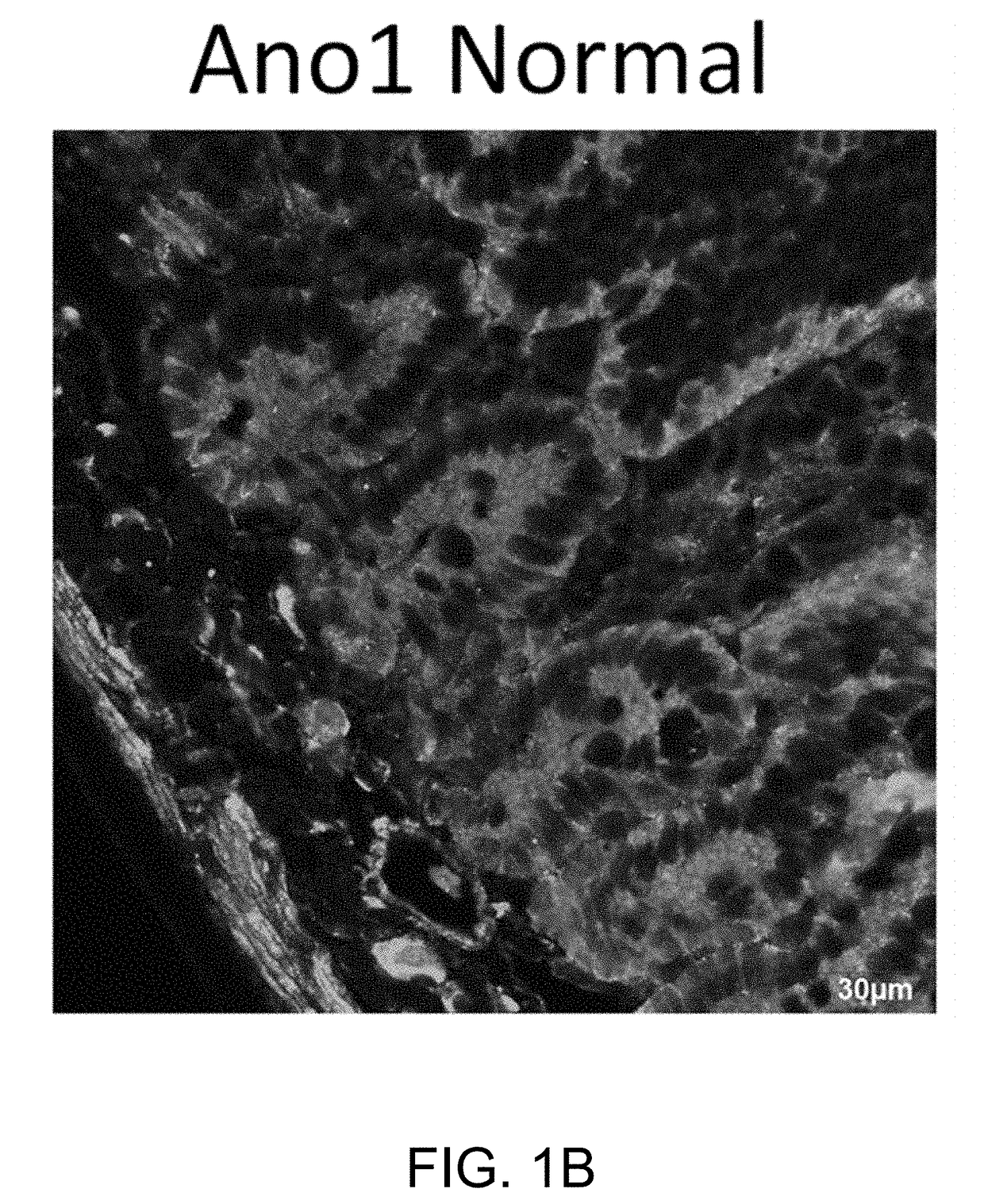Use of anoctamin as a biomarker for radiation biodosimetry
a biomarker and radiation biodosimetry technology, applied in the field of radiation biodosimetry and anoctamin, can solve the problems of severe damage to radiosensitive organs, including the bone marrow, the gastrointestinal tract, the lung, etc., and achieve the effect of reducing radiation toxicity
- Summary
- Abstract
- Description
- Claims
- Application Information
AI Technical Summary
Benefits of technology
Problems solved by technology
Method used
Image
Examples
example 1
Increases Anoctamin-1 Expression in Red Blood Cells
[0114]Anoctamin-1 expression level is increased in the membrane of red blood cells (RBCs) after irradiation. Briefly, RBC ghosts are prepared from mice that have been exposed to different radiation doses, and Western analysis is performed.
[0115]FIG. 1 (A-C) shows the anoctamin 1 protein in normal, non-irradiated mouse cells. FIG. 2 (A-F) shows the anoctamin 1 protein in mouse cells 6 days after the mice received irradiation at 3 Gy, 5 Gy, and 7 Gy, respectively. FIG. 3 shows anoctamin 1 protein expression level in mouse red blood cells 6 days after the mice received irradiation at 3 Gy, 5 Gy, and 7 Gy, respectively.
[0116]As shown in FIG. 3, the Western analysis shows that there is a radiation dose-dependent increase in anoctamin-1 expression at a radiation dose of up to about 5 Gy, while there is a marginal decrease in anoctamin-1 expression at a radiation dose of about 7 Gy; it is postulated that 7 Gy causes increased cell death in...
example 2
omarker for Radiation-Induced Acute Gastrointestinal Toxicity
[0117]Total body irradiation (TBI) results in a dose-dependent increase in gastric anion secretion. This Example shows that the expression level of ANO1 in RBC indicates acute gastrointestinal radiotoxicity.
Materials and Methods
Animal
[0118]Eight-week old NIH Swiss mice were used in this study.
Ussing Chamber
[0119]Murine ileal sections were used for transepithelial electrical current measurements after 0, 12, 24, 48, 96, 192, and 384 hours after TBI. Tissues were mounted in Ussing chambers, bathed in modified regular Ringer's solution, and gassed with 95% O2 & 5% CO2 to measure short circuit current (Isc), a measure of anion secretion. Basal readings were taken after 45 minutes, and the peak current was measured in chambers under different conditions (NSP4 and glucose+NSP4). The CaCC inhibitor niflumic acid was used to study the role of chloride secretion through CaCC.
RBC Ghosts
[0120]RBC ghosts were used, and changes in anoc...
example 3
f Enzyme-Linked Immunosorbent Assay (ELISA) for Determining Ano1 Level
[0126]In a preferred embodiment, the ANO1 level is determined using the enzyme-linked immunosorbent assay (ELISA), which can be used to determine the level of ANO1 in both native and denatured conformations.
[0127]In one embodiment, procedures for performing ELISA are illustrated as follows:
[0128]A “capture” antibody raised against ANO1 is immobilized onto the surface of a polystyrene 96-well microtiter plate. The unbound areas of the wells are blocked with bovine serum albumin or casein to minimize background. A test sample with unknown quantity of ANO1 is applied to the wells, followed by the application of a “detection” antibody for binding to ANO1, thereby forming a ternary complex (The “detection” antibody should be directed against an epitope different from that for the “capture” antibody). Next, an enzyme-linked antibody that recognizes the “detection” antibody is added, and then the enzyme's substrate is ad...
PUM
 Login to View More
Login to View More Abstract
Description
Claims
Application Information
 Login to View More
Login to View More - R&D
- Intellectual Property
- Life Sciences
- Materials
- Tech Scout
- Unparalleled Data Quality
- Higher Quality Content
- 60% Fewer Hallucinations
Browse by: Latest US Patents, China's latest patents, Technical Efficacy Thesaurus, Application Domain, Technology Topic, Popular Technical Reports.
© 2025 PatSnap. All rights reserved.Legal|Privacy policy|Modern Slavery Act Transparency Statement|Sitemap|About US| Contact US: help@patsnap.com



